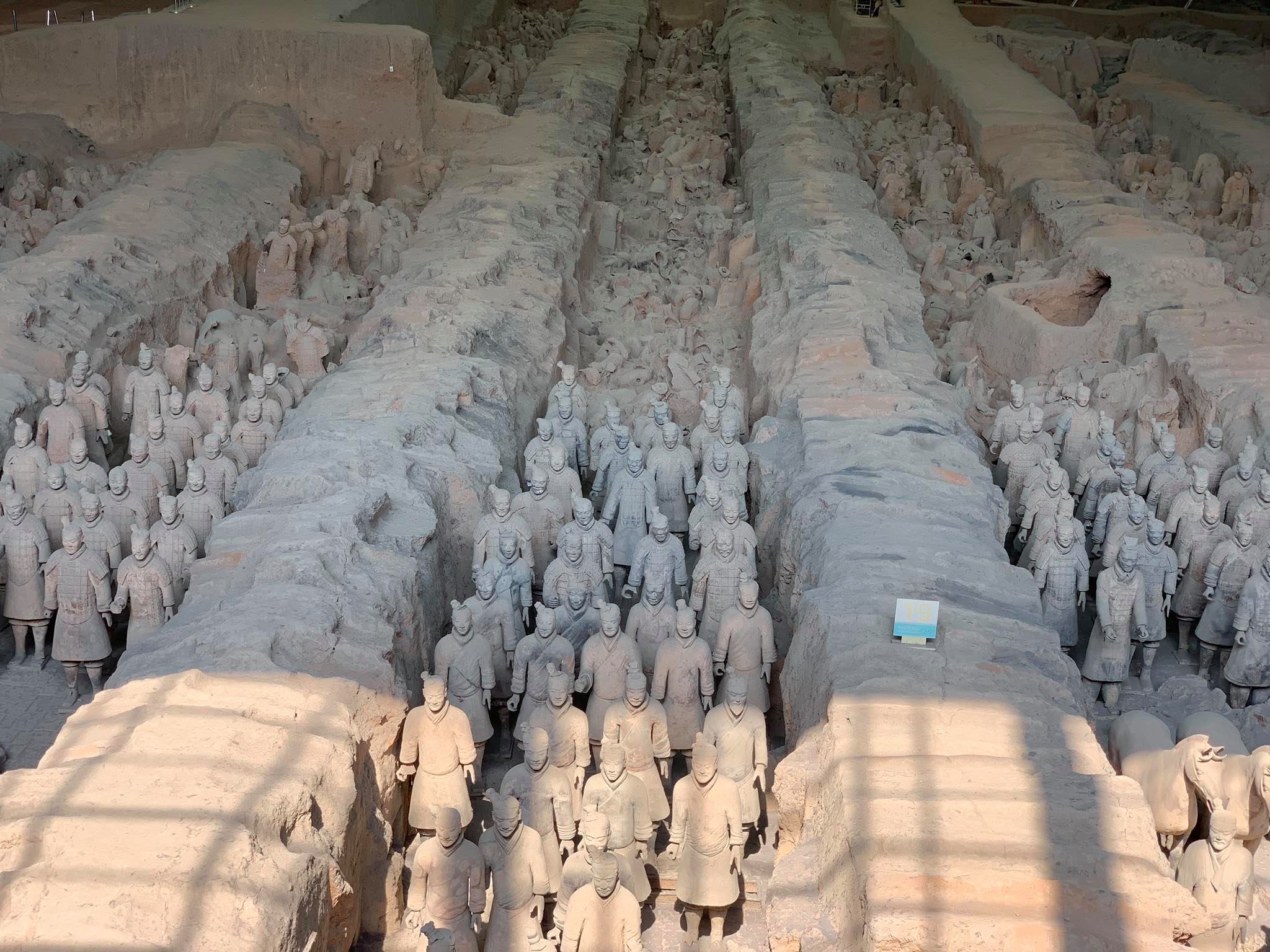This morning we had a private tour to see the Terracotta Warriors.

Our guide, Jenny, and our driver picked us up at the hotel. The Terracotta Warriors are located about an hour north east from downtown Xi’an. Along the way Jenny told us some of the history of how the Terracotta Warriors were discovered in the 1970s, and that they were built “to guard” the tomb of China’s First Emperor Qin Shihuangdi. She also described the painstaking efforts made by archaeologists to preserve them.

I had no idea that the warriors were found in pieces, and that they had to be put back together. They are highly susceptible to damage, from people and the environment. In the 80s, for example, VIP tours allowed tourists to get up close to the warriors but they soon realized how much humans suck and made a stronger effort in protecting them from opportunistic tourists. Pollution from tour buses was also causing damage to the Terracotta Army. So in 2003 they built a park from the tour buses to the Terracotta Army pits and put a 1 mile path through it so that the warriors could be kept a safe distance from the buses.

Another risk came when the area experienced a strong earthquake in 2008. Jenny told us that it struck right before open hours so tourists were not in the pits yet but scientists rushed over, terrified that decades of work putting the Terracotta Army back together would be destroyed. If just one warrior toppled, it could trigger a domino effect that could utterly destroy the entire army. As the ground shook the 300lb heavy Warriors didn’t topple over but their heads did eerily shake from side to side. It turns out that the heads are separate pieces from the bodies. The damage was minimal and the scientists could breathe a sigh of relief. It is very clear that the heads are the most fragile part of the warriors. Many heads have been lost to history because the original pieces were destroyed beyond repair.
Interestingly, archaeologists believe that the Terracotta Army was destroyed on purpose by enemies of the Emperor Qin Shihuangdi. A roof built above the army likely collapsed, crushing the warriors.
Again we were surrounded by thousands of Chinese tourists, and together we walked through the park to the entrance. We went through two bag security and passport checks. There are three pits (buildings that house the pits where they have dug up the Terracotta Army).
We went into Pit 1 first. This is the famous one, which houses reconstructed warriors standing side-by-side. It’s a really large building, with a walkway wrapped around the pit. The busiest section is near the entrance, where the Terracotta Army warriors stand guard. Their unique stony faces stare eternally at an invisible enemy. On a walkway above their eye line, a mosh pit of hundreds of sweaty bodies shoving against each other, their arms raised, clasping phones and cameras, trying to get the perfect photo.


It is an awe inspiring sight, to see the famous Terracotta Army, but it really takes you out of the moment when people are literally clawing at your body to push you out of the way. Eventually you just have to give yourself over to animal instincts and shove your way to the front, etiquette be damned.

I took my photos, spent a few moments getting a good look at the faces of the beautifully crafted warriors, and marvelled at how each one is as different as the real, human faces around me. After I was done (it might have been one minute) I pulled myself out of the crowd. Addam and G took my spot. Once they got out Addam somehow had someone else’s headphones on his shoulder. That’s how crazy it was.

While the views from the sides were not as good as the front it was still great to spend more time examining the pit and the warriors. Our tour guide took us to the other pits, one of which is a working site. It was interesting to see the state in which they find the warriors, and it’s a sad mess of broken pieces. It’s unbelievable how they are able to put them back together.

Apparently archaeologists have barely scratched the surface on uncovering and repairing all the warriors. There are thousands and it can take years for a team to find all the pieces and to fix just one.



Our tour was only meant to be a half day, but on our way our Jenny asked us if we wanted to purchase souvenirs and have lunch.
I’m still on the fence about how I feel about this part of the day. While I was researching tours in China there were many companies promoting themselves as “no shopping tours”. I love souvenirs so I thought that was odd. Do people really hate having the opportunity to buy a souvenir? And then I read horror stories about how tour guides turn into forceful, used car salesmen as they take you from store to store, trying to get you to buy things so they get a cut of your purchase.
Jenny was a really sweet tour guide but I think from the moment we said “yes” she got excited about the opportunity and it got out of hand.
She took us to meet one of the men who discovered the terracotta soldiers while farming the land. He signs guide books and takes a photo with you for a fee. It was a cute enough experience but boy the salespeople and Jenny really worked to upsell us on a myriad of souvenirs. “It is good luck to have these three warrior statues together, not just one.” “It’s more traditional to have a bigger statue.”


Then we went to a restaurant that apparently was a tea house where they give you samples of different teas and try to get you to purchase the tea in bulk. We were sweaty, tired and hungry. Hot tea was the last thing we wanted but we obliged and ate a really delicious meal.
After the restaurant we wanted to leave but Jenny was pretty insistent on us buying Jade jewelry because it brings good fortune or something. We said no a bunch of times before she finally relented.
Who knows, maybe I was just being super sensitive and she was just trying to be a helpful tour guide in telling us what would be good souvenirs. But I’m fairly certain she got a cut from our purchases and a free lunch at the restaurant where we ate. Anyway, I still highly recommend the site where we booked the private tours.
For anyone who is interested we decided to do private tours because they are 1) really affordable 2) the only convenient way to get around outside of a city without hiring a car and 3) come with an English speaking guide. We used tour-beijing.com, whose affordable prices included booking and paying for the tickets to all the attractions we visited. I can’t imagine how we would have done all we did if we had to navigate these places on our own.


